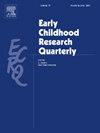早期保育和教育中心在空间上的不平等
IF 3.2
1区 教育学
Q1 EDUCATION & EDUCATIONAL RESEARCH
引用次数: 0
摘要
鉴于早期保育和教育(ECE)项目对儿童发展和父母加入劳动力队伍的重要性,确保社区(尤其是那些历史上被边缘化的人群的家园)能够可预测地、公平地获得项目和服务至关重要。然而,有用的数据资源并不多,因此对当地幼儿教育项目获取情况差异的研究也相对较少。在这篇文章中,我们利用 2000 年至 2019 年独特的全国县级幼教计划注册人数和支出数据集,按照儿童贫困率、种族和民族构成以及城乡地理位置,研究了县级幼教中心参与率和可用性方面的差异。这些数据中的幼儿教育机会衡量指标反映了公共提供和资助的项目,以及可能由非营利或营利实体运营的私营项目的混合情况。研究结果表明,农村县的公立幼儿教育人均入学率高于城市县,而私立幼儿教育项目的入学率似乎更集中在城市县。与儿童贫困率较低的县相比,儿童贫困率较高的县的私立幼儿教育中心入学率也较低。在比较各县公立(如公立学前班、启蒙教育)和私立幼教中心的种族和民族构成时,我们发现结果不一。最后,我们研究了幼儿教育入学率和支出的逐年波动性,发现公立幼儿教育项目与私立幼儿教育项目相比更加稳定,这可能会促进幼儿教育稳定性的公平性。本文章由计算机程序翻译,如有差异,请以英文原文为准。
The spatial inequality of early care and education centers
Given the importance of early care and education (ECE) programs for children's development and parents’ labor force participation, it is critical to ensure communities — particularly those home to historically marginalized populations — have predictable and equitable access to programming and services. Yet, there are few useful data resources and thus relatively little research examining variation in local access to ECE programs. In this article, we examine county-level disparities in participation in and availability of ECE centers by child poverty rate, racial and ethnic composition, and urban-rural geography using a unique national dataset of county-level ECE program enrollment and expenditures from 2000 to 2019. Measures of ECE access in these data reflect a mix of publicly provided and funded programs, as well as privately-run programs that may be operated by nonprofit or for-profit entities. Findings suggest that public ECE per capita enrollment is higher in rural than urban counties, whereas private ECE program enrollment appears more highly concentrated in urban counties. Counties with higher child poverty rates also have lower enrollment rates at private ECE centers compared to counties with lower child poverty rates. We find mixed results when comparing public (e.g., public preschool, Head Start) and private ECE enrollment across counties by racial and ethnic composition. Finally, we examine year-over-year volatility in ECE enrollment and expenditures and find that public ECE programs are more stable compared to private ECE programming, which may promote equity in ECE stability.
求助全文
通过发布文献求助,成功后即可免费获取论文全文。
去求助
来源期刊

Early Childhood Research Quarterly
Multiple-
CiteScore
7.00
自引率
8.10%
发文量
109
期刊介绍:
For over twenty years, Early Childhood Research Quarterly (ECRQ) has influenced the field of early childhood education and development through the publication of empirical research that meets the highest standards of scholarly and practical significance. ECRQ publishes predominantly empirical research (quantitative or qualitative methods) on issues of interest to early childhood development, theory, and educational practice (Birth through 8 years of age). The journal also occasionally publishes practitioner and/or policy perspectives, book reviews, and significant reviews of research. As an applied journal, we are interested in work that has social, policy, and educational relevance and implications and work that strengthens links between research and practice.
 求助内容:
求助内容: 应助结果提醒方式:
应助结果提醒方式:


